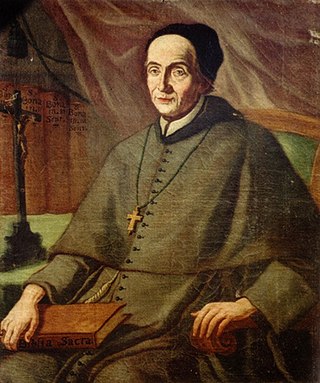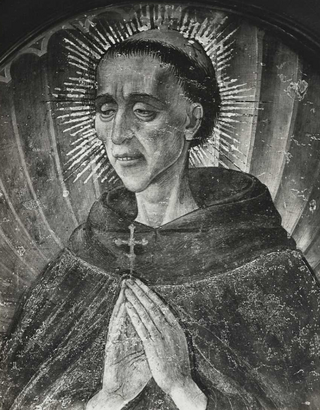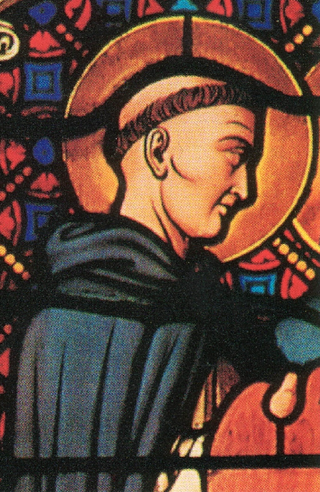
Józef Bilczewski was a Polish Roman Catholic prelate who served as the Archbishop of Lviv from 1900 until his death. He served as a theological and dogmatics professor in the Lviv college after himself having earned two doctorates in the course of his own studies. He earned a reputation as a learned and cultured man; these qualities led to Emperor Franz Joseph I nominating him for the Lviv archdiocese as its head. Pope Leo XIII named him as its archbishop and he set to work prioritizing a range of different pastoral initiatives aimed at revitalizing the faith within people and also prioritizing ecumenical cooperation with other denominations.

Antonio Lucci, born Angelo Nicola Lucci, was an Italian Roman Catholic professed member from the Order of Friars Minor Conventual and served as the Bishop of Bovino from 1729 until his death.

Leopoldo da Gaiche, born Giovanni Croci, was an Italian Roman Catholic priest and a professed member of the Order of Friars Minor who became well known for wearing a crown of thorns. He was a preacher who went from diocese to diocese and served in a position of power in the Franciscan order in the Umbrian region in which he pushed for strong adherence to the Rule of Saint Francis of Assisi. He has been called the "Apostle of Umbria".

Andrew of Montereale was an Italian Roman Catholic priest and a professed member of the Order of Saint Augustine. His life was devoted to teaching and leading the Augustinians from several positions of leadership; he was also hailed during his lifetime as a pious miracle worker.
Clemente da Osimo was an Italian Roman Catholic professed religious and a member of the Order of Saint Augustine. He was hailed as a reformer of the order.

Andrea Bertoni was an Italian Roman Catholic priest and a professed member of the Servite Order. Bertoni assumed the religious name of "Giacomo Filippo" upon being admitted to the Servites and he became the procurator of the convent he lived in from his appointment until his death.

Domenico Spadafora was an Italian Roman Catholic priest and a professed member of the Order of Preachers. Spadafora was a noted evangelist and attracted countless to the Dominican fold while also converting the hearts of others who led dissolute lives. He is best known for being the first superior of a church he oversaw construction of in Monte Cerignone after receiving the papal approval of Pope Alexander VI to commence such work.

Ugolino da Gualdo Cattaneo was an Italian Roman Catholic professed religious and friar of the Order of Saint Augustine. Ugolino is best known for founding an Augustinian convent in Gualdo Cattaneo in 1258 where he served as its prior until his death. He practiced a rigorous spiritual life with austerities including frequent bouts of strict silence and fasting.

Luca Antonio Falcone – in religious life Angelo – was an Italian Roman Catholic priest and a professed member of the Franciscan Order of Friars Minor Capuchin in Cosenza. Falcone had a rough call to religious life after several entries and exits into the order and he later served as a noted preacher across southern Italian cities such as Catanzaro and Salerno after his first few sermons attracted little following. He became titled as both the "Angel of Peace" and the "Apostle of the South".

Antonio Patrizi was an Italian Roman Catholic priest and a professed member of the Order of Saint Augustine. Patrizi joined the order in Lecceto and lived as a hermit prior to his sudden death while visiting his friend at another convent.

Giovannangelo Porro was an Italian Roman Catholic priest and hermit who hailed from the Milanese region and was a professed member of the Servites. Porro was born to nobles and became a priest after the death of his father. He remained a hermit in convents in places such as Florence and Milan where he dedicated his life to inward meditation and self-mortification until his death.
Giovanni de Surdis Cacciafronte was an Italian Roman Catholic priest and bishop from the Order of Saint Benedict. He served as the Bishop of Mantua from 1174 until his resignation in 1177 and held the position of Bishop of Vicenza from 1179 until his murder. The schism that Antipope Victor IV caused enabled him to proclaim his support for Pope Alexander III though leading to his removal from a position at the behest of Frederick Barbarossa.
Elena Valentinis was an Italian Roman Catholic professed religious from the tertiaries of the Order of Saint Augustine. Valentinis was born to nobles and married a knight during her adolescence while mothering six children before she was widowed in 1441. She soon became a professed religious and dedicated herself to austerities and a life of complete penance.

Arcangelo Canetoli was an Italian Roman Catholic priest and a canon regular of Santa Maria di Reno. Canetoli escaped the massacre of his parents and brothers who were killed in Bologna during a political feud and embraced the religious life not long after where he became noted to the point he turned down repeated offers to serve as the Archbishop of Bologna and the Archbishop of Florence.

Gregorio Celli was an Italian Roman Catholic priest and a professed member of the Order of Saint Augustine. Celli lived with the latter order in Rimini until he decided to spend the remainder of his life in deep contemplation and so moved to the region's hills where he dwelled in a cave near the Franciscans stationed there. It is claimed he was expelled from his order and became a Franciscan though there is no evidence to support this claim.

Angelo of Foligno - born Angelo Conti - was an Italian Catholic priest and a professed friar of the Order of Saint Augustine. Conti was part of the order of John the Good though became a mainstream Augustinian in 1256 after the Grand Union of the order. He was a close friend of both Saint Nicholas of Tolentino and Blessed Ugolino da Gualdo Cattaneo.
Blessed Hartmann of Brixen was a German prelate of the Catholic Church, who served as the Bishop of Brixen from his appointment in 1140 until his death. Hartmann served alongside the Order of Saint Augustine - who oversaw his education - and he managed certain aspects of their order despite not being part of that congregation. He also supported Pope Alexander III during his struggle with Frederick Barbarossa and also earned the favor of the latter despite Hartmann's views of the schism.

Pietro Corradini was an Italian Roman Catholic priest and a professed member of the Order of Friars Minor. Corradini served in several leadership positions within his order which bought him into contact with the likes of James of the Marches and Camilla Battista da Varano - he was her confessor and spiritual director - while in turn being a well-known figure due to his mild mannered nature and for his preaching abilities.
Bartolo da San Gimignano – born Bartolo Buonpedoni – was an Italian Roman Catholic priest and a member of the Third Order of Saint Francis. Bartolo was born to nobles near Siena and fled home to become a priest to escape his father's wrath. He tended to poor people in the streets and used his income to provide alms to them and to alleviate their suffering while himself contracting a disease from working with the poor and succumbing to that same disease as a result.

André Abellon, O.P. was a French Roman Catholic priest and a professed member from the Order of Preachers. He became a Dominican after hearing the preaching of Vincent Ferrer and studied art before joining their ranks. Abellon gained fame as a noted preacher and confessor but became a prominent figure after tending to victims of the plague in Aix-en-Provence in 1445. He was also a noted artist and painter with some of his works still surviving at present.














